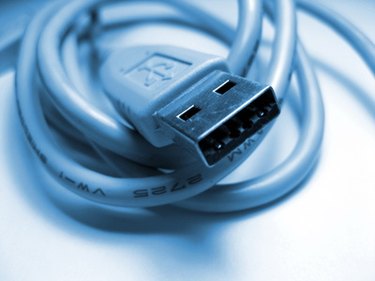
High definition multimedia interface (HDMI) and universal serial bus (USB) technologies are both popular for their respective uses. USB has become the industry standard for computer connections while HDMI cables are quickly becoming more popular as consumers purchase high definition devices. Although these connection types do not typically overlap in use, they can combine for some purposes.
History
Video of the Day
The first version of High-Definition Multimedia Interface technology became available in 2002. HDMI version 1.0 was the first technology to carry all-digital audio and visual data. Versions 1.1 and 1.2 became available in May 2004 and August 2005, respectively. HDMI technology updated to version 1.3 in June 2006 and, as of June 2009, HDMI is at version 1.4. Subsequent releases of HDMI have improved upon transferring data such as colors, image size (resolution) and transfer speed. For example, HDMI 1.4 can transfer a color depth of 48 bits per pixel and a screen resolution of up to 1920 by 1200p60 at that depth.
Video of the Day
USB 1.0 technology originated in 1996. Then, USB cables were able to transfer data at 1.5 Megabytes per. USB 2.0 emerged in 2001 with a more efficient rate of 480 Megabytes per second. Intel released the specification for the current version of this technology, USB 3.0, in August 2008. USB 3.0 technology is capable of speeds up to rate at 5.0 Gigabytes per second and is more than 125 times faster than USB 2.0 and nearly 3500 times faster than USB 1.0.
Function
According to the Practical Home Theater Guide website, HDMI-enabled devices became available to consumers in 2003. HDMI, which stands for High-Definition Multimedia Interface, is a technology that transmits uncompressed audio and visual data from one device to another. For example, a consumer may connect her Blu-Ray DVD player to her high definition televise via an HDMI cable.
In contrast, Universal Serial Bus (USB) technology typically allows devices such as personal computers and computer hardware to connect. Ajay Bhatt helped developed this technology in the 1990s as a way to combat the tricky plugs on previous connections and to reduce the need for users to install separate software for all hardware.
Benefits
HDMI connections allow users to connect high definition devices such as televisions, gaming consoles, media players (Blu-Ray, DVD) and computers. HDMI connections transfer both audio and visual data so consumers no longer need to use multiple cables for each data type. Furthermore, consumers can expect the best digital quality when using HDMI technology because HDMI connections do not compress and decompress the data between devices.
John D. Sutter of CNN explains how USB connections enable computer and hardware devices to talk in the same language. In addition to this, he says "[a]ll USB plugs are compatible. So if you buy a new computer, you don't have to upgrade all the rest of your equipment--the video cameras, mobile phones and the like." In addition to this, USB technology can also charge low powered electronics, reducing the need for AC adapters.
Considerations
The HDMI organization describes the typical effective distance of HDMI cables at 10 meters (30 feet). According to the organization, some manufacturers are creating HDMI cables that are longer and still effective or using hardware such as repeaters and amplifiers to extend this distance. However, it is not unusual for HDMI quality to deteriorate with longer cables.
As of June 2010, the current version of USB technology is 3.0, which boasts a transfer rate of 5.0 Gigabytes per second. While all USB ports are compatible with all USB connections, USB 2.0 or 3.0 will not be able to perform at their full speed with older ports.
Misconceptions
Although some devices may have ports for both HDMI and USB connections, the technologies do not typically serve the same function.
However, consumers can connect an HDMI adapter to their computer's USB port in order to transfer audio and visual data, such as a movie or television show, to their television. This adds HDMI compatibility to computers that cannot transmit HDMI data, such as older computers.